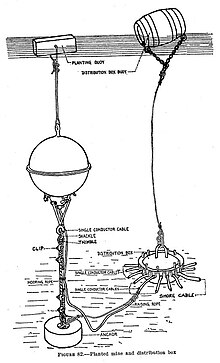Controlled mines
A controlled mine was a circuit fired weapon used in coastal defenses with ancestry going back to 1805 when Robert Fulton termed his underwater explosive device a torpedo:
Robert Fulton invented the word torpedo to describe his underwater explosive device and successfully destroyed a ship in 1805. In the 1840s Samuel Colt began experimenting with underwater mines fired by electric current and in 1842, he blew up an old schooner in the Potomac River from a shore station five miles away.[1]
History
"Torpedoes" were in use during the American Civil War when such devices were made famous with the order given by David Farragut at Mobile Bay. After that war similar mines were being contemplated or put into use by other nations.
In 1869 the
The terms "mine" and "torpedo" were used interchangeably until modern usage began separating the term with "mine" applied to static explosive devices and "torpedo" to self-propelled or "locomotive torpedo" weapons. Even during the Spanish–American War the interchangeable terms caused confusion.[5]
In Britain, the term 'Submarine Mine' was used. Fixed minefields to defend harbours were the responsibility of the
Operation

Unlike
In the United States a type of vessel termed
In the Royal Navy controlled mines were often laid alongside anti-submarine indicator loops during both World Wars; the US Navy used a similar strategy in at least World War II.[13] A dozen specialized vessels known as "Indicator Loop Mine Layers"—including three Linnet-class minelayers and nine smaller vessels—much like the U.S. mine planters, were built for the Royal Navy immediately before and during WWII. Similarly in Japan four Hashima-class cable layers were built between 1939 and 1941 for mine planting duties.
See also
References
- ^ National Park Service: Torpedo Defense: COAST DEFENSE OF THE POTOMAC Archived February 11, 2009, at the Wayback Machine
- ^ Bogart
- ^ Berhow, pp. 333-374
- ^ Chester A. Authur - Second Annual Message to Congress
- ^ The Use of Mines by the Spanish Navy
- ^ Beckett, pp. 184–5.
- ^ Short et al, pp. 1–4.
- ^ a b Westlake, pp. 15–16.
- ^ Short et al.
- ^ Army Ships - The Ghost Fleet - Coast Artillery Corps Army Mine Planter Service Archived 2011-09-27 at the Wayback Machine
- ^ The California State Military Museum - Forts Under the Sea - Submarine Mine Defense of San Francisco Bay
- ^ Ft. Miles Army Mine Planters Archived 2012-02-27 at the Wayback Machine
- ^ Indicator loops website
Bibliography
- Ian F.W. Beckett, Riflemen Form: A study of the Rifle Volunteer Movement 1859–1908, Aldershot: Ogilby Trusts, 1982, ISBN 0 85936 271 X.
- Berhow, Mark A., ed. (2015). American Seacoast Defenses, A Reference Guide (Third ed.). CDSG Press. ISBN 978-0-9748167-3-9.
- Bogart, Charles H. (2008). Controlled Mines: A History of Their Use by the United States. Merriam Press. ISBN 978-1-4357-5835-3.
- Maj O.M. Short, Maj H. Sherlock, Capt L.E.C.M. Perowne and Lt M.A. Fraser, The History of the Tyne Electrical Engineers, Royal Engineers, 1884–1933, 1933/Uckfield: Naval & Military, nd, ISBN 1-845747-96-8.
- R.A. Westlake, Royal Engineers (Volunteers) 1859–1908, Wembley: R.A. Westlake, 1983, ISBN 0-9508530-0-3.
External links
- U.S. National Park Service; Torpedo Defense - COAST DEFENSE OF THE POTOMAC
- The California State Military Museum - Forts Under the Sea - Submarine Mine Defense of San Francisco Bay
- Mine Defense -Today and Tomorrow; Coast Artillery Journal, Vol. 71, No. 3, September 1929 - .pdf from DTIC with technical information and illustrations of equipment of the day.
- Shore and Underwater Elements - Mine Facilities - Fort Miles, Del.
